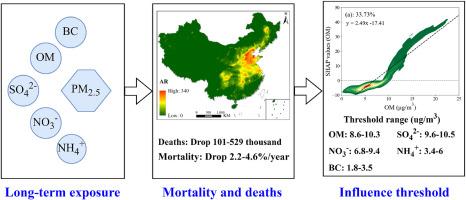Spatiotemporal evolution and risk thresholds of PM2.5 components in China from the human health perspective
IF 7.3
2区 环境科学与生态学
Q1 ENVIRONMENTAL SCIENCES
引用次数: 0
Abstract
PM2.5 is a significant global public health hazard, with its components closely linked to various fatal diseases, thereby significantly increasing mortality rates. This study analysed the spatiotemporal evolution of PM2.5-related mortality and death rates in China using risk attribution methods based on PM2.5-component and population data. The study used a LightGBM model based on Bayesian and SHAP algorithms to identify the concentration thresholds at which the components of PM2.5 affect mortality. The results showed that from 2001 to 2022, the mortality rates influenced by the five PM2.5 components showed a consistent downward trend, decreasing by 101,000–529,000, with a mean annual decrease of 2.2–4.6%. The relative importance of organic matter (OM), nitrate (NO3-) and ammonium (NH4+) in influencing mortality increased by 6.3, 17.4 and 4% respectively, while the relative importance of black carbon (BC) and sulphate (SO42-) in influencing mortality decreased rapidly to approximately 2%. The contribution of OM and SO42- to mortality exceeded 30%, with thresholds of 8.6–10.3 and 9.6–10.5 μg/m3, respectively. The thresholds for the effects of NO3-, NH4+, and BC on mortality were 6.8–9.4, 3.4–6, and 1.8–3.5 μg/m3, respectively. This study provides effective insights for policymakers to help formulate targeted air pollution control measures and optimise public health interventions to support human health and sustainable societal development.


从人类健康角度看中国 PM2.5 成分的时空演变和风险阈值
PM2.5是一种重大的全球公共卫生危害,其成分与各种致命疾病密切相关,从而显著增加死亡率。本研究采用基于pm2.5成分和人口数据的风险归因方法,分析了中国pm2.5相关死亡率和死亡率的时空演变。该研究使用基于贝叶斯和SHAP算法的LightGBM模型来确定PM2.5成分影响死亡率的浓度阈值。结果表明:2001 - 2022年,受PM2.5 5组分影响的死亡人数呈持续下降趋势,减少101,000-529,000人,年均下降2.2% - 4.6%;有机质(OM)、硝态氮(NO3-)和铵态氮(NH4+)对死亡率的影响相对重要性分别上升了6.3%、17.4%和4%,而黑碳(BC)和硫酸盐(SO42-)对死亡率的影响相对重要性迅速下降至2%左右。OM和SO42-对死亡的贡献率超过30%,阈值分别为8.6 ~ 10.3和9.6 ~ 10.5 μg/m3。NO3-、NH4+和BC对死亡率影响的阈值分别为6.8 ~ 9.4、3.4 ~ 6和1.8 ~ 3.5 μg/m3。这项研究为决策者提供了有效的见解,帮助他们制定有针对性的空气污染控制措施,并优化公共卫生干预措施,以支持人类健康和可持续的社会发展。
本文章由计算机程序翻译,如有差异,请以英文原文为准。
求助全文
约1分钟内获得全文
求助全文
来源期刊

Environmental Pollution
环境科学-环境科学
CiteScore
16.00
自引率
6.70%
发文量
2082
审稿时长
2.9 months
期刊介绍:
Environmental Pollution is an international peer-reviewed journal that publishes high-quality research papers and review articles covering all aspects of environmental pollution and its impacts on ecosystems and human health.
Subject areas include, but are not limited to:
• Sources and occurrences of pollutants that are clearly defined and measured in environmental compartments, food and food-related items, and human bodies;
• Interlinks between contaminant exposure and biological, ecological, and human health effects, including those of climate change;
• Contaminants of emerging concerns (including but not limited to antibiotic resistant microorganisms or genes, microplastics/nanoplastics, electronic wastes, light, and noise) and/or their biological, ecological, or human health effects;
• Laboratory and field studies on the remediation/mitigation of environmental pollution via new techniques and with clear links to biological, ecological, or human health effects;
• Modeling of pollution processes, patterns, or trends that is of clear environmental and/or human health interest;
• New techniques that measure and examine environmental occurrences, transport, behavior, and effects of pollutants within the environment or the laboratory, provided that they can be clearly used to address problems within regional or global environmental compartments.
 求助内容:
求助内容: 应助结果提醒方式:
应助结果提醒方式:


